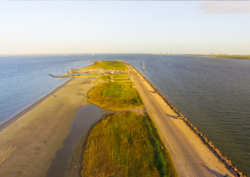

Water is essential for our sustained existence and to gain a greater understanding of this resource, HARC provides in-depth analyses to share with policymakers, communities, and local governments. HARC’s water research emphasizes the protection of watersheds, the impacts and solutions of nature-based infrastructure, and sharing the importance of healthy coastal ecosystems.
View Water ResourcesThe larger Galveston Bay watershed begins at the Trinity River’s headwaters and extends south from the Dallas-Fort Worth metroplex to Houston and ultimately to the Galveston Bay. Half of all Texas residents live in the Galveston Bay watershed. Activities that occur in the upper watershed can impact downstream waterways and the Bay.
Science-based analyses for resource planning are vital to clean, plentiful water in Texas. HARC’s Water team seeks to provide knowledge and resources on waterway’s health from riparian corridors to reservoirs to bayous through a watershed approach.

Protecting and maintaining critical infrastructure is vital to thriving communities. Innovative approaches to infrastructure, such as nature-based solutions, are a critical tool towards increased resilience to climate change that can provide flood mitigation, increase recreation and tourism opportunities, reduce runoff, improve water quality and provide many other co-benefits to communities. Approaches may include open conserved lands or developed living shorelines that can deliver several benefits to a single project, such as flood mitigation, erosion, and runoff management.
Through implementation and analyses of low impact development projects, detailed investigations on water infrastructure resilience, innovative approaches in conservation of lands for nature-based infrastructure and assessing climate impacts through vegetation studies, HARC’s Water team implements innovative strategies in assessing built and natural infrastructure.

The Texas coast supports seven major and three minor bay systems. Commercial and recreational fishing and boating are essential economic industries along the Texas coast. The Gulf of Mexico’s nearshore environment is one of the most productive and biologically rich ecological areas of the United States’ coastal margin. The Texas coast comprises tidal, subtidal, and freshwater wetland habitats. These habitats support diverse and dynamic communities of organisms in a temperate to tropical climate region.
Along the Gulf coast lie many long and narrow barrier islands; the area comprises marshes and swamps and stretches of sandy beach. Coastal habitats rely upon healthy and productive ecosystems. HARC’s Water team’s science-based approach to coastal protection includes stakeholder-driven analyses on the health of Galveston Bay, assessing climate change impacts and coastal resilience and large-scale data investigations on coastal habitat and wildlife trends.
